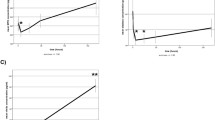Summary
The nitrovasodilator and nitric oxide donor molsidomine and its metabolite SIN-I dilate vascular smooth muscle and inhibit platelet activation by increasing intracellular concentrations of cyclic GMP We have therefore studied the effects of molsidomine and SIN-I on isolated human polymorphonuclear leucocytes (PMN)in vitro andex vivo.
In vitro molsidomine dose-dependently reducedβ-glucuronidase release and the generation of superoxide anions from non-activated and from FMLP- or PAF-stimulated human PMNs. SIN-1 was equally effective in reducing (β-glucuronidase release and totally inhibited oxygen radical generation at a concentration of 580 μmol · l−1.
In a double-blind, placebo-controlled, randomized trial we also studiedβ-glucuronidase release and the generation of superoxide anions from isolated PMNs. Blood was drawn from 12 healthy volunteers before and 3 h after oral molsidomine (16 mg) or placebo. There was no statistically significant difference inβ-glucuronidase release and superoxide anion formation when the PMNs were isolated before or after molsidomine or placebo. This was the case for non-activated, as well as FMLP- or PAF-stimulated PMNs.
Thus, the nitric oxide donors molsidomine and its metabolite SIN-I caused a dose-dependent inhibition of PMN functionsin vitro, but no significant inhibition when the PMNs were isolated after oral molsidomine.
Similar content being viewed by others
References
Böhme E, Spies C, Grossmann G (1982) Wirksamer Metabolit von Molsidomin und Stimulation der cGMP Bildung durch Sydnonimine. In: Bassenge E, Schmutzler H (eds) Molsidomin — Neue Aspekte zur Therapie der ischämischen Herzerkrankung. Urban & Schwarzenberg, München
Klocking HP, Hoffmann A, Markwardt F (1987) Release of plasminogen activator by molsidomine and its metabolite SIN-I. Pharmazie 42:354–356
Grodzinska L, Hafner G, Darius H (1990) Effect of molsidomine on t-PA and PAI activity in man: a double blind, placebo controlled study. Thromb Haemost 64:485
Grodzinska L, Kostka-Trabka E, Bleron K, Slawin ski M. Goszcz A (1992) Molsidomine — NO-donor in patients with atherosclerosis of the lower limbs. J Drug Devel (in press)
Darius H, Ahland B, Rücker W, Klaus W, Peskar BA, Schrör K (1984) The effects of molsidomine and its metabolite SIN-1 on coronary vessel tone, platelet aggregation and eicosanoid formation in vitro- inhibition of 12-HPETE biosynthesis. J Cardiovasc Pharmacol 6:115–121
Fiedler VB (1982) Reduction of occlusive coronary artery thrombosis and myocardial ischemia by molsidomine in anesthetized dogs. Can J Physiol Pharmacol 60:1104–1109
Schröder H, Ney P, Woditsch J, Schrör K (1990) Cyclic GMP mediates SIN-1-induced inhibition of human polymorphonuclear leukocytes. Eur J Pharmacol 182:211–218
Ney P, Schröder H, Schrör K (1990) Nitrovasodilator-induced inhibition of LTB4 release from human PMN may be mediated by cyclic GMP. Eicosanoids 3:243–245
Romson JL, Hook BG, Kunkel SL, Abrams GD, Schork MA, Lucchesi BR (1983) Reduction of the extent of ischemic myocardial injury by neutrophil depletion in the dog. Circulation 67:1016–1023
Mehta JL, Nichols WW, Mehta P (1988) Neutrophils as potential participants in acute myocardial ischaemia: relevence to perfusion. J Am Coll Cardiol 11:1309–1316
Engler RL, Dahlgren MD, Morris D, Petersen M, SchmidSchönbein GW (1986) Role of leukocytes in response to acute myocardial ischemia and reflow in dogs. Am J Physiol 251:H314-H322
Darius H, Grodzinska L, Hafner G, Meyer J (1991) Wirkung von Molsidomin auf die fibrinolytische Aktivität: Eine doppelblinde, randomisierte Studie. Ztschr Kardiol 80 [Suppl 5]:47–50
Drummer C, Valta-Seufzer U, Karrenbrock B, Heim J-M, Gerzer R (1991) Comparison of anti-platelet properties of molsidomine, isosorbide-5-mononitrate and placebo in healthy volunteers. Eur Heart J 12:541–549
Slany J, Silberbauer K, Sinzinger H (1982) Wirkung von Molsidomin auf die Thrombozytenfunktion und das Prostaglandinsystem. In: Bassenge E, Schmutzler H (eds) Molsidomin — Neue Aspekte zur Therapie der ischämischen Herzerkrankung. Urban & Schwarzenberg, München
Kukovetz WR, Holzmann S (1985) Mechanism of vasodilation by molsidomine. Am Heart J 109:637–640
Feelisch M, Noack E (1987) Correlation between nitric oxide formation during degradation of organic nitrates and activation of guanylate cyclase. Eur J Pharmacol 139:10–30
Noack E, Feelisch M (1989) Molecular aspects underlying the vasodilator action of molsidomine. J Cardiovasc Pharmacol 14 [Suppl 11]:S1-S5
Author information
Authors and Affiliations
Rights and permissions
About this article
Cite this article
Darius, H., Grodzinska, L. & Meyer, J. The effects of the nitric oxide donors molsidomine and SIN-1 on human polymorphonuclear leucocyte functionin vitro andex vivo . Eur J Clin Pharmacol 43, 629–633 (1992). https://doi.org/10.1007/BF02284962
Received:
Accepted:
Issue Date:
DOI: https://doi.org/10.1007/BF02284962




